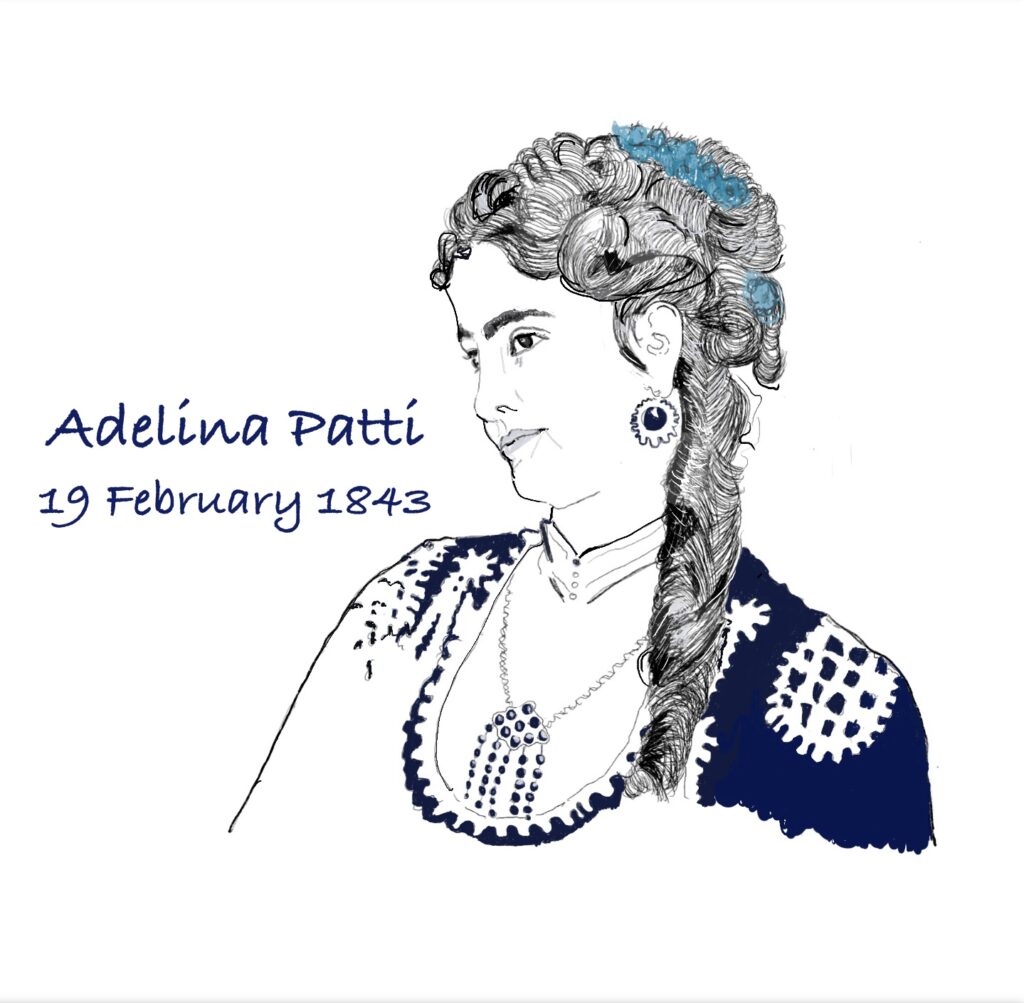ADELINA PATTI
SOPRANO
FEBRUARY 19, 1843

On February 19, 1843, Adelina Patti was born in Madrid, the daughter of Sicilian parents, who were both professional singers, her father a tenor and her mother a soprano. With such a start no wonder the great composer Giuseppe Verdi was able to say of her, ‘She is perfectly organised. Perfect balance between singer and actress, a born artist in every sense of the word.’[1] Verdi when asked which three sopranos were his favourites, famously replied, ‘First, Adelina; second, Adelina; third, Adelina.’[2] Yet George Bernard Shaw when writing about Patti in 1888, noted that she would, ‘bow to you in the agony of stage death if you only dropped your stick accidentally.’[3]
According to John Roselli, Patti was in real terms the highest paid opera singer in history. Patti commanded 10,000 francs per performance when average colleagues would make anything between 500 to 1,000 francs per month! She was gifted not only with a pure voice, doll-like looks and acting but, ‘a notable competence in running her career and a will of iron.’[4] In her heyday she was better paid than such notable thespian contemporaries, Sarah Bernhardt and Henry Irving, not to mention her operatic colleagues. What did she do with this fortune you may ask? Patti was able buy a Welsh castle, Craig-y-Nos, with her second husband and in her 150 seat private theatre perform for invited guests. This was inaugurated on 12 August 1891 with the first act of la Traviata and the third act of Faust. Patti’s husband sang the role of Mephistopheles in the latter.[5] You can still see both the castle and theatre as its now a hotel. What is sadly also true is that although, ‘the best singers still earn well,.. the greater economic and social equality of our time is incompatible with fees at Patti level.’[6] But despite being lady of the manor in Craig-y-Nos, we must also remember that Adelina Patti sang an annual charity concert in Swansea
Yet it would be churlish to view Adelina Patti from the perspective of her success. In New York the conductor Giulio Arditi, in his memoirs noted the young girl, ‘first selected a comfortable seat for her doll in such proximity that she was able to see her while singing,’ and when young Adelina sang, I wept genuine tears of emotion, tears which were the outcome of the original and never-to-be-forgotten impression her voice made when it first stirred our innermost feelings…’ [7] Whatever Patti possessed vocally, it was something any lover of classical singing must surely regret not having been able to hear. At her London debut in la Sonnambula in 1861 one critic wrote, ‘Mdlle. Patti is a triumphant refutation of the assumption that art and genius have deserted the operatic stage,’[8]
Her career was guided from the start. Her first teacher, her brother-in-law, Maurice Strakosch, decided she must stop singing at age ten to allow her voice to develop.[9] She did make her debut at age sixteen in the title role of Lucia di Lammermoor!
A curious incident in San Francisco in 1884 is that the greatest operatic performer of her age survived an attempt to murder her with a bomb thrown from the gallery. The terrorist threw wildly though and the bomb exploded in a box. Consummate artist that she was, her courage never failed her. She never lost her nerve in a crisis and in New Orleans, as the overcrowded gallery was starting to sink, she calmed the audience by singing’ Home, Sweet, Home’ without accompaniment allowing a safe evacuation to take place![10] A similar event took place in Budapest where someone had screamed out, Fire!’ and Patti calmed the audience.
Perhaps we should finish with the judgement of Eduard Hanslick, arguably the greatest music critic of the nineteenth century, ‘he had heard more brilliant voices, seen more sophisticated actresses, and more beautiful women, but Patti’s appeal consisted in making him forget them.’[11]
[1] GILBERT, S. AND SHIR, J; A TALE OF FOUR HOUSES, HARPER COLLINS, LONDON 2003, P.408
[2] GATTEY, C.N., QUEENS OF SONG, BARRIE & JENKINS, LONDON 1979, P.73
[3] IBID. 109
[4] ROSELLI, J., SINGERS OF ITALIAN OPERA, CAMBRIDGE UNIVERSITY PRESS , CAMBRIDGE 1992. P.116
[5] ARDITI. G., MY REMINISCENCES, DODD, MEAD AND COMPANY, NEW YORK 1896, P.256
[6] IBID. P.215
[7] IBID. P.70
[8] IBID. P.74
[9] IBID. P.110
[10] IBID. P.135
[11] IBID. P.116